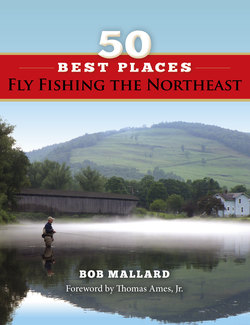Читать книгу 50 Best Places Fly Fishing the Northeast - Bob Mallard - Страница 31
На сайте Литреса книга снята с продажи.
Оглавление3 . West Branch Penobscot River
Location: North-central Maine, about a 2-hour ride from Bangor, a 4-hour ride from Portland; and a 5½-hour ride from Boston, Massachusetts. Full-service airports are available in all three cities.
The West Branch Penobscot is the finest self-sustaining, river-dwelling landlocked Atlantic salmon fishery in Maine—and arguably the finest in the country. While not native to the river, landlocked salmon have thrived in the West Branch since their introduction in the
late 1800s. This is due largely to an abundance of spawning habitat, a diverse forage base, and coolwater releases. The river also holds a significant population of wild native brook trout. However, salmon far outnumber the trout.
The West Branch flows 117 miles before emptying into the Penobscot River. It begins at Seboomook Lake northwest of Moosehead Lake. The river runs roughly 25 miles before entering Chesuncook Lake. Below the lake, it flows approximately 20 miles before entering Pemadumcook Chain of Lakes. It drops roughly 1,775 feet from its headwaters to Medway. The river was once host to runs of Atlantic salmon. This ended with the construction of a series of dams that blocked passage.
The West Branch has a rich history. It once served as a route of travel and reflection for author and naturalist Henry David Thoreau. His book The Maine Woods chronicles his exploration of the river and the Mount Katahdin region. The river
also served as a conduit for “driving,” the hazardous work of moving logs downstream to mills, which finally ended in the 1970s when trucking became the transportation mode of choice. The dangerous task of moving wood down the rough waters of the West Branch fell to teams of river drivers. Many lost their lives while working the river. Their tales live on around flickering campfires.
The land surrounding the West Branch is some of the most rugged and beautiful in the Northeast. The views are second to none. Maine’s highest point, Mount Katahdin (5,269 feet) and other distant peaks in Baxter State Park are constantly in view. The area is home to a wide variety of wildlife including eagles, ospreys, mink, coyotes, beavers, otters, deer, and a large population of moose. The area
is a popular destination for hiking, whitewater rafting, canoeing, and wildlife watching.
The West Branch is located west of Millinocket amid a vast working forest. The river corridor is protected by conservation easements that prohibit development. With the exception of a few private camps, two campgrounds, and a handful of rustic campsites, the West Branch looks much the way it did when Thoreau visited the area. Power and phone service end roughly 8 miles west of Millinocket. Access to the river is gained via the fabled Golden Road, a private road open to the public. Logging
Mount Katahdin from below Nesowadnehunk Falls. Maine River Guides
trucks have the right of way. Heed all warning signs, and park well off the road.
The West Branch is a large freestone river. Flows are controlled by McKay Power Station, roughly ¾ mile downstream of Ripogenus Dam. Between Ripogenus Dam and McKay Station, there is a short stretch of river with a natural flow regime. The average flow below McKay Station is between 2,200 and 3,200 cfs.
The roughly 10-mile section between McKay Station and Abol Bridge is the most popular with fly fishers—it offers the best fishing and access. The Golden Road parallels the river. From McKay to Big Eddy, the West Branch is a rugged river with Class III–V whitewater. Here the river
